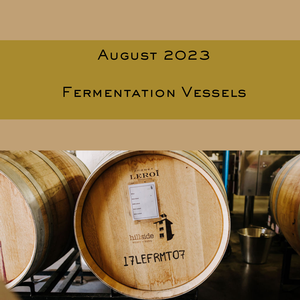As we prepare for our favourite time of year—grape harvest, affectionately referred to as “crush” not for what it does to the crew and winemaker, but what we do to the grapes—we plan and strategize our use of fermentation vessels for each block of grapes.
Because red and white wines are made very differently, we need tanks of different styles to facilitate production.
Red wines are fermented on the skins, as the skins contain the components that give red wine its colour and structure. The red fermentation tanks are designed to enable removal of the skins after fermentation. They have very large, rectangular “man-doors” at the bottom of the side wall and well-sloped floors. At the end of fermentation, the wine is drained through a side valve, the bottom door is opened, and the skins are “dug” into a pump which transfers them to the press.
These red fermenters are outside at Hillside and have glycol jackets which can circulate cold glycol, for cold-soaking, or warm glycol which heats the juice and skins pre-fermentation and keeps wine warm during extended skin-contact post-fermentation. We keep them wrapped with thermal insulation for maximum efficiency.
White wines are fermented as juice, so need to be removed from skins and other solids directly after harvesting. Grapes are hand-picked into half-ton bins as early in the morning as possible, assuring that the fruit is cool and flavours and aromas well-preserved. The clusters are dumped onto the sorting line, sorted and pumped to the press where they will have some skin-contact time before being drained and pressed into white fermentation tanks.
These stainless-steel tanks are inside the winery cellar and fitted with very efficient cooling jackets which circulate chilled glycol around the outside of the tank. They have slightly-sloped bottoms and at least two valves—one at the bottom of the tank, and one a few feet higher, just below the “man” door. The juice is cooled down in these tanks for cold-settling, allowing grape solids to separate and drop to the bottom of the tank. This takes about three days, and the juice goes from looking like grapefruit juice to like apple juice.
The juice is now “racked” off solids. It is transferred out through the higher of the valves, called the racking valve, leaving a layer of sediment at the bottom of the tank. The door can now be opened, any remaining clear juice syphoned off the top, and the sediment, or juice lees (the French call it bourbes) removed to compost. The juice in its new tank is now yeasted, and fermentation occurs, controlled by adjusting the temperature using the glycol jackets.
Some fermentation vessels can change the character of white wines. Oak barrels are used during fermentation to add flavour and aroma but more importantly to allow for lees contact after fermentation. The sediment at the bottom of the barrel consists of spent yeast cells which break down over time, releasing components which add to the mouthfeel, imparting texture and creaminess. During this time the barrels are stirred periodically to expose the wine to these components. In France this is referred to as time spent “sur lies”.
We use as many “neutral” barrels—older barrels which no longer impart oak flavours—as possible to capitalize on this lees contact. In fact, the Sauvignon Blanc is fermented only in neutral French oak. Check out our previous blog on Why We Use Oak in Winemaking.
Artisan-crafted from sandstone, this jarre is the latest innovation to Hillside’s winemaking program. The shape of this tank is designed to work with gravity to create a natural dynamic current through the wine. This serves to continually stir up the lees achieving a similar effect to barrel stirring, without adding flavour and aroma.
This jarre was acquired last fall and used to “finish” a component of the 2022 Heritage Viognier, so that this wine has a complexity arising from both time in jarre, and barrel fermentation and stirring, rounding off the bright flavour and acidity preserved by stainless steel fermentation.
Future harvests will see Sauvignon Blanc fermented in this jarre—contributing texture and mouthfeel to the wine without oak flavours.

